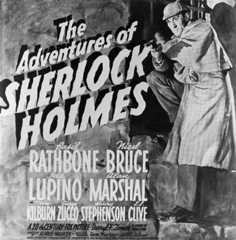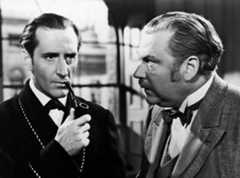Sherlock Holmes
Our editors will review what you’ve submitted and determine whether to revise the article.
- BBC Culture - How Sherlock Holmes changed the world
- ABC listen - Overnights - Profiling the world's only consulting detective Sherlock Holmes
- The Victorian Web - Sherlock Holmes's Addictions
- History Net - Sherlock Holmes: The History of the Mystery
- The Arthur Conan Doyle Encyclopedia - Sherlock Holmes
- Official Site of The Sherlock Holmes Museum
- Bridgewater State University - Virtual Commons - A Study in Sherlock: Revisiting the Relationship between Sherlock Holmes and Dr. John WatsonHolmes and Dr. John Watson
Was Sherlock Holmes a real person?
Sherlock Holmes is a fictional character created by the Scottish writerArthur Conan Doyle. However, Conan Doyle did model Holmes’s methods and mannerisms on those of Dr. Joseph Bell, who had been his professor at theUniversity of Edinburgh Medical School. Conan Doyle took inspiration from Bell’s method of diagnosing a patient’s disease.
How is Sherlock Holmes so smart?
Sherlock Holmes’s success as a “consulting detective” comes from his uncanny ability to gather evidence based upon his honed skills of observation anddeductive reasoning. Holmes offered some insight into his method, claiming, “When you have excluded the impossible, whatever remains, however improbable, must be the truth.”
Does Sherlock Holmes die?
Claiming that Sherlock Holmes distracted him “from better things,”Arthur Conan Doyle in 1893 famously attempted to kill him off in the story “The Final Problem.” Public outcry against the death of Holmes was great. By popular demand, Conan Doyle resurrected his detective in the story “The Adventure of the Empty House” (1903).
Who is Sherlock Holmes’s nemesis?
Sherlock Holmes’s greatest nemesis isProfessor James Moriarty whom Holmes considers the “Napoleon of Crime.” The character of Professor Moriarty recurs in several detective stories and novels byArthur Conan Doyle. Similar to Sherlock Holmes’s character having real-life inspiration, it is believed that Conan Doyle based Moriarty on Adam Worth, a real criminal who was active at the time.
Who does Sherlock Holmes marry?
Sherlock Holmes never marries anyone inArthur Conan Doyle’s original stories. The only woman whom Holmes ever holds in high regard is Irene Adler—one of few characters to be clever enough to get past him. Though only appearing in Conan Doyle’s “A Scandal in Bohemia” (1891), she has often been portrayed as a potential love interest of Holmes in contemporary adaptations.
Sherlock Holmes, fictional character created by the Scottish writerArthur Conan Doyle. Theprototype for the modern masterminddetective, Holmes first appeared in Conan Doyle’sA Study in Scarlet, published inBeeton’s Christmas Annual of 1887. The first collection of the Holmes’ tales, published asThe Adventures of Sherlock Holmes, appeared in 1892. As the world’s first and only “consulting detective,” he pursued criminals throughout Victorian and Edwardian London, the south of England, and continental Europe. Although the fictional detective had been anticipated byEdgar Allan Poe’sC. Auguste Dupin andÉmile Gaboriau’s Monsieur Lecoq, Holmes made a singular impact upon the popular imagination and has been the most enduring character of thedetective story.
Conan Doyle modeled Holmes’s methods and mannerisms on those of Dr. Joseph Bell, who had been his professor at the University of Edinburgh Medical School. In particular, Holmes’suncanny ability to gather evidence based upon his honed skills of observation anddeductive reasoning paralleled Bell’s method of diagnosing a patient’s disease. Holmes offered some insight into his method, claiming that “When you have excluded the impossible, whatever remains, however improbable, must be the truth.” His detecting abilities become clear, though no less amazing, when explained by his companion,Dr. John H. Watson, who recounts the criminal cases they jointly pursue. Although Holmes rebuffs praise, declaring his abilities to be “elementary,” the oft-quoted phrase “Elementary, my dear Watson,” never actually appears in Conan Doyle’s writings. (See alsoSherlock Holmes: Pioneer in Forensic Science.)
Watson’s narrations describe Holmes as a very complex and moody character who, although of strict habit, is considerably untidy. His Londonabode at 221B, Baker Street, is tended by his housekeeper, Mrs. Hudson. Holmes appears to undergo bouts of mania and depression, the latter of which are accompanied by pipe smoking, violin playing, andcocaine use. Throughout the four novels and 56 short stories featuring Holmes, a number of characters recur, including the bumblingScotland Yard inspectorLestrade; the group of “street Arabs” known as the Baker Street Irregulars, who are routinely employed by Holmes as informers; his even wiser but less ambitious brother, Mycroft; and, most notably, hisformidable opponent,Professor James Moriarty, whom Holmes considers the “Napoleon of crime.”

Claiming that Holmes distracted him “from better things,” Conan Doyle famously in 1893 (“The Final Problem”) attempted to kill him off; during a violent struggle on Switzerland’sReichenbach Falls, both Holmes and hisnemesis, Professor Moriarty, are plunged over the edge of theprecipice. Popular outcry against thedemise of Holmes was great; men wore black mourning bands, the British royal family wasdistraught, and more than 20,000 readers cancelled their subscriptions to the popularStrand Magazine, in which Holmes regularly appeared. By popular demand, Conan Doyle resurrected his detective in the story “The Adventure of the Empty House” (1903).
Holmes remained a popular figure into the 21st century. Among the most popular stories in which he is featured are “The Adventure of the Blue Carbuncle” (1892), “The Adventure of the Speckled Band” (1892), “The Adventure of the Six Napoleons” (1904), and thenovelThe Hound of the Baskervilles (1902). Holmes’s character has been translated to other media as well, and he is widely known on both stage and screen. The earliest actor to have essayed the role isWilliam Gillette (a founding member of theNew York Holmes society still known as the Baker Street Irregulars), who gave several popular theatrical portrayals at the turn of the 20th century. Those who appeared as Holmes onscreen includeBasil Rathbone, Peter Cushing, Jeremy Brett,Robert Downey, Jr.,Benedict Cumberbatch, and Jonny Lee Miller. Ironically, two of the emblems of Holmes, his meerschaum pipe and deerstalker hat, are not original to Conan Doyle’s writings. Gillette introduced the curved meerschaum pipe (it is thought to have been easier on the actor’s jaw during a long performance), and Sidney Paget the deerstalker (or “fore-and-aft”) cap—it was de rigueur for country living—in more than one illustration forThe Strand of Holmes at work on his investigations in the country.
In addition tomyriad translations of the Holmes adventures throughout the world, agenre of parodies and pastiches has developed based upon the Sherlock Holmes character. The mystery drama television seriesHouse (2004–12), starringHugh Laurie, Omar Epps, and Robert Sean Leonard, was a medical take on Holmes and Watson. Holmes was even played by a dog in the 1990s children’s television showWishbone (1995–98).
An entire collection of more scholarly “higher criticism” of Conan Doyle’s writings was initiated byRonald Knox’s “Studies in the Literature of Sherlock Holmes” (1912). Subsequent highercriticism is epitomized by the work appearing inThe Baker Street Journal (begun 1946), published by the Baker Street Irregulars. Holmes devotees, known as Sherlockians or Holmesians, frequently gather in societies around the world to pay tribute to the master detective with a cultist fervor. The most established of these societies are the invitation-onlyBaker Street Irregulars, founded in 1934, and theSherlock Holmes Society of London, founded in 1951 and open to anyone. The latter, which publishesThe Sherlock Holmes Journal, traces its origins to the Sherlock Holmes Society that was formed in London in 1934 and counted among its members the scholar and writerDorothy L. Sayers; it hadceased its activities by the 1940s.


















